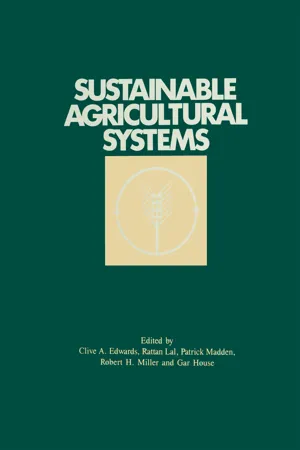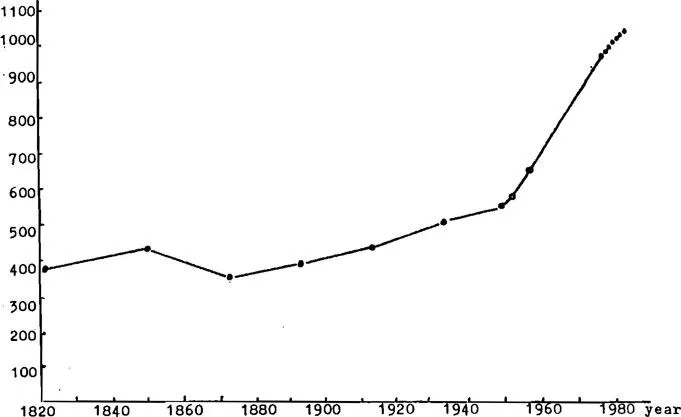
- 712 pages
- English
- ePUB (mobile friendly)
- Available on iOS & Android
eBook - ePub
Sustainable Agricultural Systems
About this book
A unique look at how the adoption of sustainable farming methods is being pursued throughout the world. This comprehensive book provides clear insight into research and education needs and the many points of view that come to bear on the issue of sustainability. Essential for agricultural leaders in research, education, conservation, policy making, and anyone else interested in creating an economically and environmentally sustainable agriculture worldwide.
Frequently asked questions
Yes, you can cancel anytime from the Subscription tab in your account settings on the Perlego website. Your subscription will stay active until the end of your current billing period. Learn how to cancel your subscription.
No, books cannot be downloaded as external files, such as PDFs, for use outside of Perlego. However, you can download books within the Perlego app for offline reading on mobile or tablet. Learn more here.
Perlego offers two plans: Essential and Complete
- Essential is ideal for learners and professionals who enjoy exploring a wide range of subjects. Access the Essential Library with 800,000+ trusted titles and best-sellers across business, personal growth, and the humanities. Includes unlimited reading time and Standard Read Aloud voice.
- Complete: Perfect for advanced learners and researchers needing full, unrestricted access. Unlock 1.4M+ books across hundreds of subjects, including academic and specialized titles. The Complete Plan also includes advanced features like Premium Read Aloud and Research Assistant.
We are an online textbook subscription service, where you can get access to an entire online library for less than the price of a single book per month. With over 1 million books across 1000+ topics, we’ve got you covered! Learn more here.
Look out for the read-aloud symbol on your next book to see if you can listen to it. The read-aloud tool reads text aloud for you, highlighting the text as it is being read. You can pause it, speed it up and slow it down. Learn more here.
Yes! You can use the Perlego app on both iOS or Android devices to read anytime, anywhere — even offline. Perfect for commutes or when you’re on the go.
Please note we cannot support devices running on iOS 13 and Android 7 or earlier. Learn more about using the app.
Please note we cannot support devices running on iOS 13 and Android 7 or earlier. Learn more about using the app.
Yes, you can access Sustainable Agricultural Systems by Edwards,Clive A. Edwards in PDF and/or ePUB format, as well as other popular books in Sciences biologiques & Biologie. We have over one million books available in our catalogue for you to explore.
Information
IV
SUSTAINABLE AGRICULTURAL SYSTEMS IN THE TROPICS
19
ECOLOGICAL AGRICULTURE IN CHINA
Shi ming Luo and Chun ru Han
After a study of agriculture in China, Korea, and Japan in the early 1900s, F. H. King (1911) wrote Farmers of Forty Centuries. Since then, new forms of agricultural practice, such as organic farming (Oelhat, 1978), biodynamic agriculture (Koepf et al., 1976), natural farming (Masonabu, 1978), ecological agriculture (Worthington, 1981), and biological agriculture, have emerged in the West (Boeringa, 1980). Many methods proposed in these alternative agricultural systems are not strange to Chinese farmers. They are similar to the methods practiced in their homeland for generations. However, Chinese farmers today are using herbicides, plastic sheets, pelleted feed, tractors, hybrid seeds, and so on.
At this stage, an ecological agricultural concept, different from the Western concept, was proposed in China. An introduction to the historical background and present situation is important in understanding why the concept of ecological agriculture was proposed and how it relates to traditional Chinese agriculture and the modernization of Chinese agriculture.
The origin of agriculture in China can be traced back more than 7,000 years (Cheng, 1978). The development of that agriculture has been seriously shaped by nature and society. Those most widely practiced and recorded in ancient Chinese agricultural literature were ecologically reasonable and sustainable (Dang, 1988; Fan, 1985; Xia, 1979).
The Challenge to Chinese Agriculture
In the last century, especially in the past 30 years, the basic condition of China’s agriculture has changed greatly. The population has increased exponentially from about 400 million before 1900 to 1,041 million in 1985 (Figure 1). Representing about 22.2 percent of the world’s population, the Chinese rely on 9 percent of the world’s arable land. Worldwide, an average of 3.47 people have one hectare of arable land. In China, each hectare of arable land must support 7.5 people, which is a heavy burden.
Great efforts were made to increase cropland in the 1960s and early 1970s by terracing hilly areas, plowing grassland in semiarid areas, or enclosing muddy sea beaches along the coast. However, the rate of increase in cropland could not match the loss of cropland for nonagricultural usage and the increase in population. From 1957 to 1977, 26.7 million hectares of farmland were lost. The average farmland per person declined 1.9 percent each year, from 0.18 hectare in 1949 to about 0.13 hectare in 1983. Before the late 1970s, the ecosystem concept had not been established widely in China. Most efforts to increase cropland neglected the ecological consequences. This intensified the problems of soil erosion and desertification.
Today, of China’s 9.6 million square kilometers of land, about 10.3 percent is arable land, 33.0 percent is grassland, 12.0 percent is forest, 2.8 percent is inland water surface, 0.2 percent is seabeach, and the rest is desert or built-up areas. The eroded area has increased from 1.16 million square kilometers in the 1950s to 1.50 million square kilometers in the 1980s. More than 50 million tons of topsoil are lost each year. About 7 million hectares of cultivated land have saline-alkali soils. About 30.3 percent of the grassland is overgrazed and degenerating. Desertification reaches 17 million hectares; 29.4 percent of those deserts formed in the past 50 years. Only about 0.8 percent of the land is potentially arable (Agricultural Regionalization Committee of China, 1987). Total production increases in the past 30 years were due mainly to yield increases. For example, total grain production in 1985 was 2.87 times that in 1950, while the grain yield in 1985 was 2.82 times that in 1950. During this period, grain crop areas decreased from 114.41 million hectares in 1950 to 108.84 million hectares in 1985 (Figure 2).


Since the 1950s, the Chinese have paid great attention to increasing crop yield by increasing inputs and improving varieties and cultural methods. For a long period, agricultural modernization in China meant “mechanization, electrification, chemicalization, and adequate irrigation.” Obviously, it was a model adapted from developed countries. The subsidized energy input of China’s agriculture has increased exponentially (Figure 3). From 1952 to 1982, large- and middle-sized tractors increased from 1,307 to 812,000, hand tractors increased from zero to 1,671,000, the rural electricity supply increased from 50 million kilowatt hours to 3,969 million kilowatt hours, and chemical fertilizer supplies increased from 0.3 million tons to 68.1 million tons. Pesticide production increased from 1,920 tons to 456,900 tons. The area irrigated by water pump increased from 0.3 million hectares to 25.1 million hectares (Editorial Board of Agricultural Yearbook of China, 1980–1987).
As a result of these efforts, food production did increase faster than the population growth. The total population in 1985 was 1.81 times that in 1952, while total grain production in 1985 was 2.31 times that in 1952. The nutrition of Chinese people has been improving continually (Human Population Research Center of the Chinese Academy of Science, 1985).
Can these high-input strategies be successful in the future? After analysis of the general situation, two main difficulties can be identified. First, it is difficult for China to reach the high-input levels common in developed countries. In China, national production per person in 1983 was only $230.6 U.S., whereas it was $2,655.1 in the Soviet Union, $13,887.0 in the United States, and $8,973.1 in Japan. Energy consumption per person in China is only about 9 percent of that in the United States. Although about 10 percent of the commercial energy in China is used in the agricultural sector, biological energy is still the main energy resource in rural China (Wu, 1983).
Second, the application rate of chemical fertilizers in China already is rather high (Table 1). Diminishing returns of input increases can be found in China’s production records (Table 2). It is certain that the ...
Table of contents
- Cover
- Half Title
- Title Page
- Copyright Page
- Table of Contents
- Foreword
- Preface
- Introduction
- I. An Overview of Sustainable Agriculture
- II. Components of Sustainable Agricultural Systems
- III. The Importance of Integration in Sustainable Farming Systems
- IV. Sustainable Agricultural Systems in the Tropics
- V. Policy Development for the Low-input Sustainable Agriculture Program
- VI. Improved Ecological Impacts of Sustainable Agriculture
- Contributors
- Index